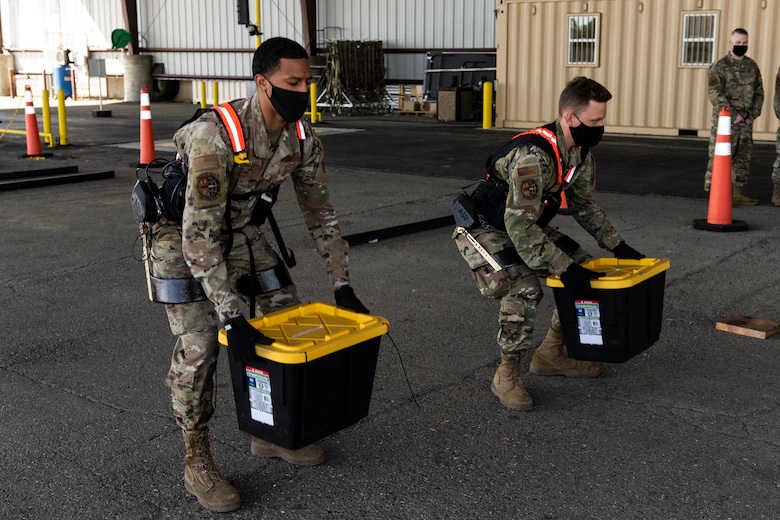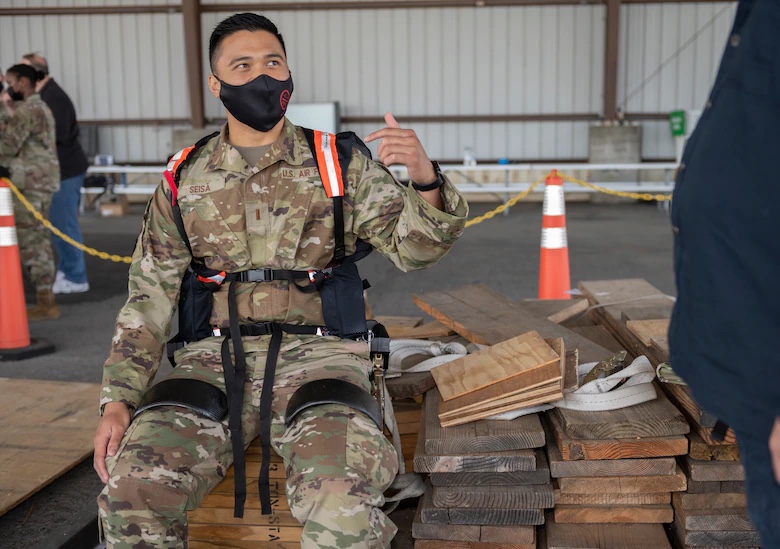TRAVIS AIR FORCE BASE, Calif. (AFNS) —
The Air Force Life Cycle Management Center and Air Mobility Command partnered with Arizona State University to develop the Aerial Port Exoskeleton, a new piece of equipment set to be used in an official capacity at Travis Air Force Base, May 17.

The Aerial Port Exoskeleton helps aerial porters perform their duties with less strain.
“Aerial ports have a high injury rate in the Air Force,” said Tech. Sgt. Landon Jensen, Air Mobility Command innovations, systems and future command manager. “That’s why we are looking into this kind of solution to help porters perform their duties more safely while also helping reduce the risk of injuries, so they are not suffering later in life.”
Travis AFB is currently serving as the test base for the new exoskeleton equipment. If the equipment proves to be beneficial, it will be utilized throughout the Air Force.
“We began looking into this equipment because of the outcome of the 2019 Volpe study,” Jensen said. “The Volpe study was a Department of Transportation study that focused on why retired aerial porters alone were costing upwards of $31 million a year on disability benefits.”

Following the results of the 2019 study, the 60th Aerial Port Squadron leadership looked into working with external parties to develop a solution reducing the number of Airmen leaving service in such a rough state.
“This project would have been impossible without the help of Arizona State University,” said 2nd Lt. Aaron Cox, Air Force Life Cycle Management Center program manager. “They focused on the development and manufacturing of the exoskeleton, and without their partnership we wouldn’t have been able to develop this technology.”
After a month-long testing period, the Airmen expressed the suits are a good investment and significantly reduces load bearing.
“This suit’s core function is to help us lift, but can also be used in other ways,” said Airman 1st Class Kyle Sunderman, 60th APS ramp serviceman. “During a load, fatigue can be a real issue and these exoskeletons really take a lot of the strain away.”
However, as with any new piece of equipment, it is not without fault, but the Airmen say they still feel safe.

“There are small things here and there where the suits can be improved to make them more user friendly,” said Airman 1st Class Xaviar Archangel, 60th APS aerial porter. “But there is no danger and these suits don’t have the strength to overpower the user, so I feel completely safe in it.
“These suits are pretty light,” Archangel said. “You hardly notice you are wearing them aside from the bulk around the waist. “But other than that, I could honestly wear these for an extended period with no problems if necessary.”
The Aerial Porter Exoskeleton is still in its prototype stage and will continue to be updated as data is recorded.
By SrA Cameron Otte, 60th Air Mobility Wing Public Affairs


Lt. Ripley approves.
https://www.youtube.com/watch?v=YPMk-EEyOpE
Whatever happened with Mawashi’s exoskeleton? It appeared to be far more advanced and ergonomic that this thing?